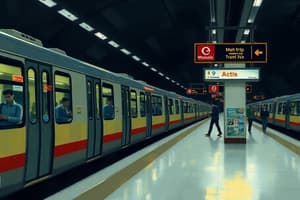Podcast
Questions and Answers
What is the typical line capacity for Bus Rapid Transit (BRT) stations and stops?
What is the typical line capacity for Bus Rapid Transit (BRT) stations and stops?
- 30,000 - 50,000 spaces per hour
- 1,000 - 5,000 spaces per hour
- 6,000 - 24,000 spaces per hour (correct)
- Above 50,000 spaces per hour
What is a key characteristic of BRT stations regarding buses?
What is a key characteristic of BRT stations regarding buses?
- Long waiting times for passengers
- Fast passenger exchange at stops (correct)
- Inefficient design leading to overcrowding
- Limited doors for passengers to enter/exit quickly
In the context of BRT stations, what does ITS stand for?
In the context of BRT stations, what does ITS stand for?
- Intermodal Transport Service
- Internal Ticketing System
- Intelligent Traffic System (correct)
- Internal Transfer System
What distinguishes Light Rail Transit (LRT) in terms of technical maximum speeds?
What distinguishes Light Rail Transit (LRT) in terms of technical maximum speeds?
What is a characteristic feature of Rail Rapid Transit (RRT) stations regarding platforms?
What is a characteristic feature of Rail Rapid Transit (RRT) stations regarding platforms?
What is the primary power source for Rail Rapid Transit (RRT) systems?
What is the primary power source for Rail Rapid Transit (RRT) systems?
What distinguishes Regional Rapid Transit lines in terms of station spacings?
What distinguishes Regional Rapid Transit lines in terms of station spacings?
Which transit mode operates with frequencies up to 40 trains per hour?
Which transit mode operates with frequencies up to 40 trains per hour?
What is a common operational characteristic of rapid transit systems?
What is a common operational characteristic of rapid transit systems?
"Fail-safe" signal systems are commonly associated with which type of transit operation?
"Fail-safe" signal systems are commonly associated with which type of transit operation?
Flashcards are hidden until you start studying




